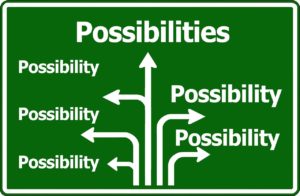Small Nonprofit Series: Is Our Nonprofit Too Small for a CRM?
No. Here’s Why Every Nonprofit Should Invest In a Donor Management Platform
Let’s get one thing straight right away. I am not a technology buff. I don’t get excited about gadgets and goofy services like cameras in my house or on my front porch that the whole world can hack into, or ovens I can turn on from Canada, or thermostats that can measure my body temperature.
That stuff doesn’t impress me, and I don’t want or need any of it.

Image by Alexas_Fotos from Pixabay
So when small nonprofit clients ask me if they should get a CRM, and if it’s worth the investment since they have such a small budget, I don’t say “Yes” just because it’s ‘cloud-based,’ works on mobile, and everyone else is doing it so you should too. Those are inadequate reasons to make a decision that requires this much time and money.
The truth here is simple: Every nonprofit should get a CRM, no matter how small the organization.
Even for a new nonprofit bringing in as little as $5000 per year with an all-volunteer staff, I would still recommend getting a CRM.
Why? Because if you have any intention of growing or expanding, if you work with volunteers, if you run events, if you have donors and expect to acquire more – a CRM does things that otherwise will take you ten times as long, if you can do them at all.
What Is a CRM?
CRM stands for customer relationship management. For nonprofits, they are really DRMs then, for donors instead of customers. But the principles behind them are the same.
A CRM’s best quality is that it saves you time. It automates things that you would otherwise have to do by hand. Here’s a partial list of what you can do with a CRM. Please note – not all CRMs necessarily perform all these tasks.
What a CRM Can Do For Your Small Nonprofit
✓ Accepts donations from multiple channels
With a CRM, you can take and process donations from social media, your website, email, direct mail, and even at events. And, you can take them by check, by credit card, by direct deposit through ACH, and just about any other way that gets dreamed up. We’re talking about far more than just a Paypal button.
Paypal is not a CRM. It’s a payment processor. It was not designed for the task of managing all your financial transactions.
✓ Automates the delivery of tax receipts

Image by Michal Jarmoluk from Pixabay
How much time would you spend having to churn these out one at a time in Word, and then email them to each recipient? Hours. Days if you have a lot of donors. It would be absurd. And remember – you have to do all the year-end receipts in January. There is a clock, and it’s ticking.
✓ Event registration
Again, not all CRMs do everything on this list. I’ll share resources for finding the best CRM for you in a moment. But some CRMs can help streamline your event registration and other management tasks. For any nonprofits that do fundraising events of any sort, a CRM will make the job easier.
✓ Auction management
An auction is a specific type of fundraising event, with specific needs. With the right CRM, you can manage the details for your silent, live, and online auctions.
8 ways to make money at your next fundraising auction
✓ Send emails, or integrate with your email provider
Most CRMs have their own email service, though it’s often not as good as the email providers like Constant Contact, which you can try free for 60 days if you’re looking for a new one.
And most CRMs know that organizations prefer to keep using their existing providers. So they often integrate with the most well known ones. When choosing a CRM, be sure to find out if it integrates (talks to) your preferred email provider.
✓ Renews memberships and recurring donors
CRMs automate your most critical tasks, such as keeping your recurring donors, recurring. The best CRMs can also inform you of when a donor’s credit card has expired.
✓ Creates customized donation pages
Too many nonprofits use the same donation page for all purposes. You will convert more donors if you create specific donation pages for each purpose. For example, you can have a Giving Tuesday donation page, a capital campaign donation page, an urgent one-time goal donation page, a matching grant donation page, and a page for any other purpose that arises.
The more personalized and specific, the more it will speak to donors who want to give to that specific need. With the right CRM, you can create as many donation pages as you like – and they will be aligned with your brand. Unlike a Paypal page.
7 Donation Page Improvement Tips – from Real A/B Experiments
✓ Manages volunteers
Ask your volunteer coordinator if they could use help with this. If they’re trying to keep track of everyone by hand – they need help! This is a tough and busy job. A CRM will make it much easier.
And you’ll end up with happier volunteers who want to keep coming back. That’s what happens when people receive timely and relevant communication.
9 Ways to Keep More Volunteers
✓ Stores data in the cloud
Okay, I know I made fun of this earlier, but cloud-based storage is actually a good thing. First, it is more secure. If your computers get compromised in some way, such as a cyberattack, fire, or theft, you’ll still have all your data.
Second, you can store a lot more information because cloud-based storage limits far exceed the computer in your office. There are other benefits to cloud-based storage as well. Just about any CRM offers this benefit.
There is so much more you can accomplish with CRMs depending on the one you choose, such as mail merge for emails or direct mail, grant management, online petitions and advocacy, contact segmentation, and so much more.
Even for a small nonprofit, if you want to stay afloat and grow, you need to do most of the tasks on this list. A CRM will allow you to do more with the limited time and staff resources you’re working with.
How Do We Choose the Right CRM for Our Small Nonprofit?

Image by Gerd Altmann from Pixabay
I have used a couple of CRMs, enough to know what they can do, but I am not an expert in the specifics of most of them. So, here are a couple of resources you can use to get started.
Click the blue headings to visit the sites.
Nonprofit CRM options from Software Advice
Software Advice gives a brief description of each CRM, and it includes a price rating system. As a small nonprofit, you’ll be drawn first to the $ and $$-rated CRMs. But don’t ignore the mid-level priced ones either. Often they have different pricing tiers. And spending an extra $20 a month in order to save an extra 10 hours of work each week might still be worth it, depending on the specifics.
Compare 15 CRMs at ‘Double the Donation’
This list has some overlap with the first one, but they approach it in a different way.
Here, you get a quick sense of the specialization of certain CRMs. For instance, they list one that specializes in churches, another for cultural nonprofits like museums, and others for higher education, social activism, and different sized nonprofits.
You’ll also find a variety of price structures. Some charge monthly or annually. One charges nothing per month, but takes 1% of your donations processed.
Is Choosing a Nonprofit CRM a Lot of Work?
Yes. This is not something you can do in a couple hours. You want to get the right one. And let’s be clear about something – most CRMs are fairly frustrating. So if you look at reviews, you will find negative reviews for all of them.
What you’re looking for is one that does the tasks most critical for your nonprofit, at a price you can afford, and with fairly simple usability. Some CRMs rely on a strong knowledge of code and html, for example, and others rely less on that. Look for one that works at your skill level.
Important Warning when choosing a CRM:

Image by Clker-Free-Vector-Images from Pixabay
Whatever you do, do NOT let a volunteer – especially a tech volunteer – choose your CRM for you. There are two reasons for this.
First, volunteers come and go. If your tech volunteer chooses the CRM, sets it all up, loves it, but then disappears, what do you have left? A big confusing mess no one can decipher.
Second, volunteers don’t have time to manage a CRM. This is an ongoing job, not suited for volunteers. So if you let a tech volunteer who loves code choose your CRM, you’re going to be the person who ends up working with it, because they will likely not be able to carry the load on an ongoing basis.
Your volunteers are not different. Ignore this warning at your own peril.
You’ll want to call and hopefully get a demo from at least three different CRMs, especially if you’ve never worked with one before.
Is Learning the CRM a Lot of Work?
Yes. There is a learning curve, and a lot of setup work. It will take time to get it going.
But once you get the system humming, you’ll be doing things in minutes that would have taken hours before, perhaps days – if they were even possible.
Relying on Excel sheets, Google docs, and other inefficient and disorganized methods adds stress to your small nonprofit staff, and wastes valuable time.
You can do much more in less time. For small nonprofits, which often have just one full-time worker, time is often more valuable the money.
A CRM is worth the investment.
Take the time to choose the right one.
Learn the system.
Get organized.
And then get out there and raise more money.
Think your nonprofit is too small to send emails consistently? Think again.
Use this 7-step small nonprofit guide to writing emails
Want more content? Get weekly nonprofit fundraising and copywriting tips, strategies, and motivations in the ProActive Insights newsletter.

